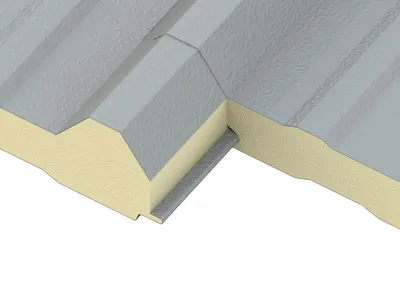


The LS-36™ insulated and exposed metal wall and roof panel achieves unsurpassed insulation values. The panel offers versatility given its design options, functioning as wall or roof for a variety of commercial and industrial applications. The overlapping, through-fixed joint paves the way for efficient installation, resulting in reduced labor and energy costs. The panel can be used on roof slopes as low as 1/2″:12″
36”
8′-0″ to 50′-0″, see material specifications
G-90 galvanized steel or AZ-50 aluminum-zinc coating in 26, 24 or 22 Ga.
U-factor (BTU/h-ft2*fahrenheit)
Panel width: 36 in. at 35 degrees
WALL | ROOF
1.5″ = 0.071 | 0.071
2″ = 0.055 | 0.054
2.5″ = 0.044 | 0.044
3″ = 0.037 | 0.037
4″ = 0.028 | 0.029
5″ = 0.023 | 0.023
6″ = 0.019 | 0.020
R-value (h*ft2*F/BTU)
Panel width: 36″ to 35 degrees
1,5″ = 13,4
2″ = 17,9
2,5″ = 22,4
3″ = 26,9
4″ = 35,9
5″ = 44,8
6″ = 53,8
Fluropon, Fluropon Premier, Fluropon Classic, Flurothane, Flurothane Coastal, WeatherXL, Igloo White Polyester
Thermal values, including R-value and U-value, are crucial metrics used in building construction and insulation to quantify the ability of materials to resist heat transfer. Here’s what each means:
1. ** R** value:
– The R-value measures a material’s thermal resistance, indicating its ability to resist heat flow. The higher the R value, the better the insulation.
– It’s a measure of thermal resistance per unit area. So the thicker the insulation (or the higher its thermal resistance), the higher the R-value.
– The R-value is commonly used in the USA and some other countries to specify insulation performance for various building components such as walls, roofs and floors.
– Higher R-values are desirable in colder climates to minimize heat loss in buildings during winter.
2. ** U coefficient**:
– The U-value is the thermal transmittance of a material, indicating the rate of heat transfer through it. The lower the U-value, the better the insulation.
– Unlike the R-value, which measures resistance, the U-value measures the amount of heat that can pass through a material.
– This is the reciprocal of the R-value. So a material with a high R-value will have a low U-value.
– The U-value is commonly used in Europe and other parts of the world to quantify the insulating properties of windows, doors and other building components.
– Lower U coefficients are desirable in hot and cold climates to reduce the amount of heat transferred through building components, thus improving energy efficiency.
In summary, R-value and U-value are complementary metrics used to assess the insulating properties of materials. While the R-value measures thermal resistance, indicating a material’s ability to prevent heat flow, the U-value measures thermal transmittance, indicating the amount of heat that can pass through a material. Both are essential for designing energy-efficient buildings and choosing appropriate insulation materials.
Customized solutions to meet your needs and expectations